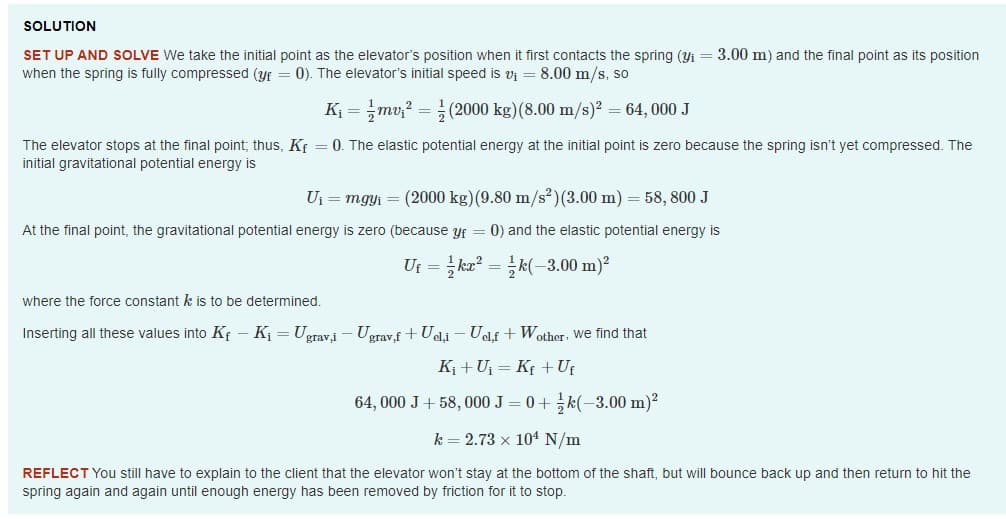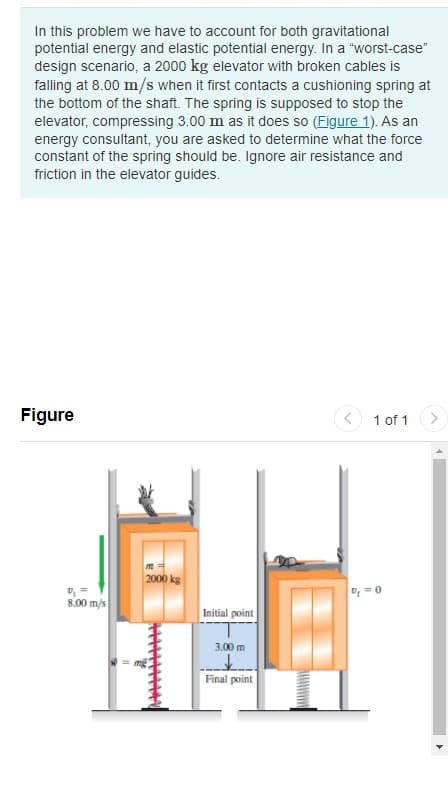Physics for Scientists and Engineers: Foundations and Connections
1st Edition
ISBN:9781133939146
Author:Katz, Debora M.
Publisher:Katz, Debora M.
Chapter8: Conservation Of Energy
Section: Chapter Questions
Problem 32PQ: The Flybar high-tech pogo stick is advertised as being capable of launching jumpers up to 6 ft. The...
Related questions
Question
If the mass of the elevator (with four fewer passengers than before) is 1600 kg, what should the spring constant be for a maximum compression of 3.00 m?

Transcribed Image Text:SOLUTION
SET UP AND SOLVE We take the initial point as the elevator's position when it first contacts the spring (yi = 3.00 m) and the final point as its position
when the spring is fully compressed (yf = 0). The elevator's initial speed is vi = 8.00 m/s, so
K = mv;? =(2000 kg)(8.00 m/s)? = 64, 000 J
The elevator stops at the final point; thus, Kf = 0. The elastic potential energy at the initial point is zero because the spring isn't yet compressed. The
initial gravitational potential energy is
Uj = mgyi = (2000 kg) (9.80 m/s²)(3.00 m) = 58, 800 J
At the final point, the gravitational potential energy is zero (because yf = 0) and the elastic potential energy is
Uf = ka? = k(-3.00 m)?
where the force constant k is to be determined.
Inserting all these values into Kf - K = Ugravi – Ugrav.f + Ueli - Uelf + Wother: we find that
Ki + U = Kf + Ut
64, 000 J+ 58, 000 J = 0+ k(-3.00 m)?
k = 2.73 x 104 N/m
REFLECT You still have to explain to the client that the elevator won't stay at the bottom of the shaft, but will bounce back up and then return to hit the
spring again and again until enough energy has been removed by friction for it to stop.

Transcribed Image Text:In this problem we have to account for both gravitational
potential energy and elastic potential energy. In a "worst-case"
design scenario, a 2000 kg elevator with broken cables is
falling at 8.00 m/s when it first contacts a cushioning spring at
the bottom of the shaft. The spring is supposed to stop the
elevator, compressing 3.00 m as it does so (Figure 1). As an
energy consultant, you are asked to determine what the force
constant of the spring should be. Ignore air resistance and
friction in the elevator guides.
Figure
1 of 1
2000 kg
8.00 m/s
Initial point
3.00 m
mg
Final point
Expert Solution
This question has been solved!
Explore an expertly crafted, step-by-step solution for a thorough understanding of key concepts.
Step by step
Solved in 2 steps

Knowledge Booster
Learn more about
Need a deep-dive on the concept behind this application? Look no further. Learn more about this topic, physics and related others by exploring similar questions and additional content below.Recommended textbooks for you

Physics for Scientists and Engineers: Foundations…
Physics
ISBN:
9781133939146
Author:
Katz, Debora M.
Publisher:
Cengage Learning

University Physics Volume 1
Physics
ISBN:
9781938168277
Author:
William Moebs, Samuel J. Ling, Jeff Sanny
Publisher:
OpenStax - Rice University

An Introduction to Physical Science
Physics
ISBN:
9781305079137
Author:
James Shipman, Jerry D. Wilson, Charles A. Higgins, Omar Torres
Publisher:
Cengage Learning

Physics for Scientists and Engineers: Foundations…
Physics
ISBN:
9781133939146
Author:
Katz, Debora M.
Publisher:
Cengage Learning

University Physics Volume 1
Physics
ISBN:
9781938168277
Author:
William Moebs, Samuel J. Ling, Jeff Sanny
Publisher:
OpenStax - Rice University

An Introduction to Physical Science
Physics
ISBN:
9781305079137
Author:
James Shipman, Jerry D. Wilson, Charles A. Higgins, Omar Torres
Publisher:
Cengage Learning

Principles of Physics: A Calculus-Based Text
Physics
ISBN:
9781133104261
Author:
Raymond A. Serway, John W. Jewett
Publisher:
Cengage Learning

Physics for Scientists and Engineers with Modern …
Physics
ISBN:
9781337553292
Author:
Raymond A. Serway, John W. Jewett
Publisher:
Cengage Learning

Physics for Scientists and Engineers
Physics
ISBN:
9781337553278
Author:
Raymond A. Serway, John W. Jewett
Publisher:
Cengage Learning